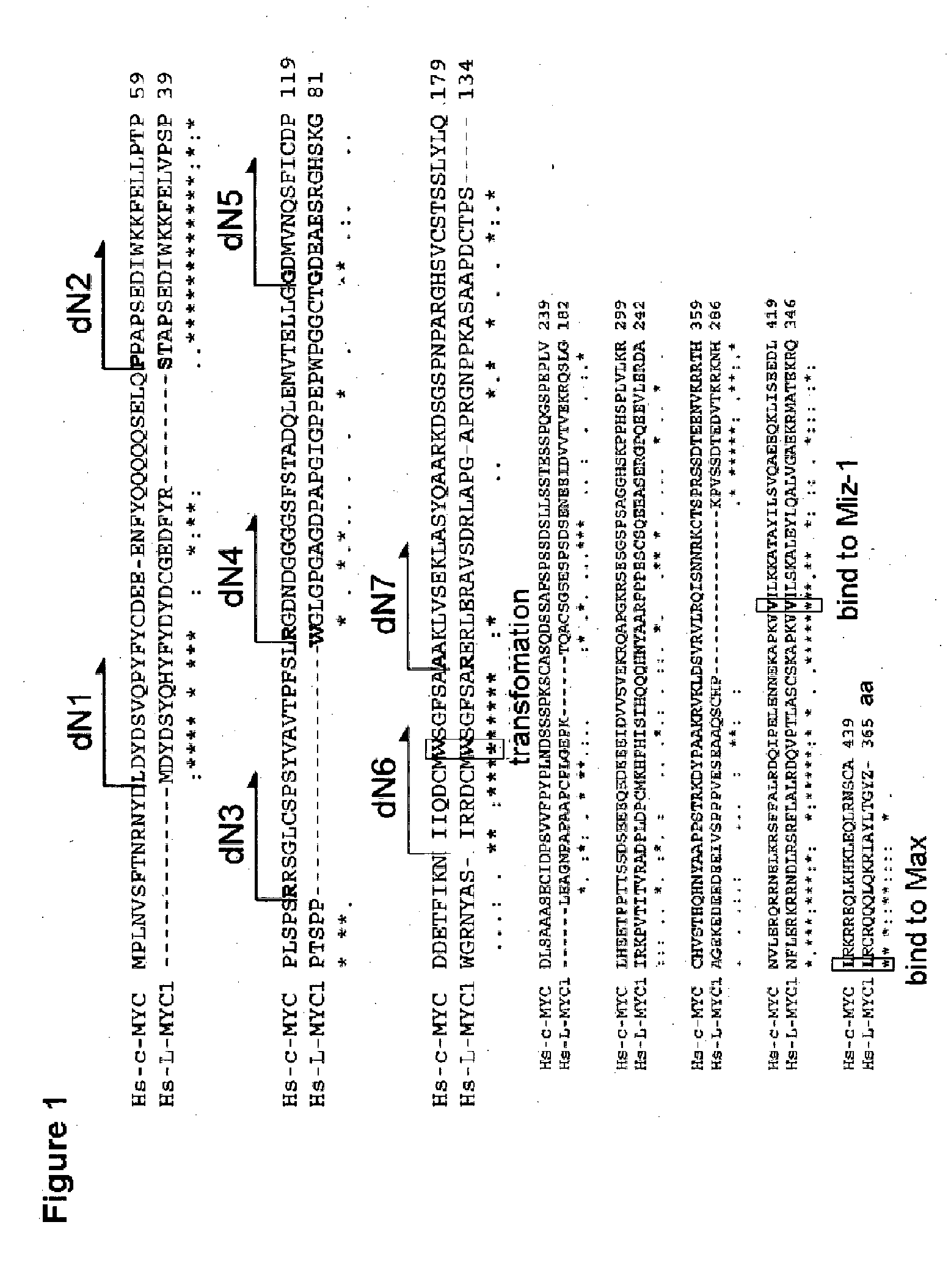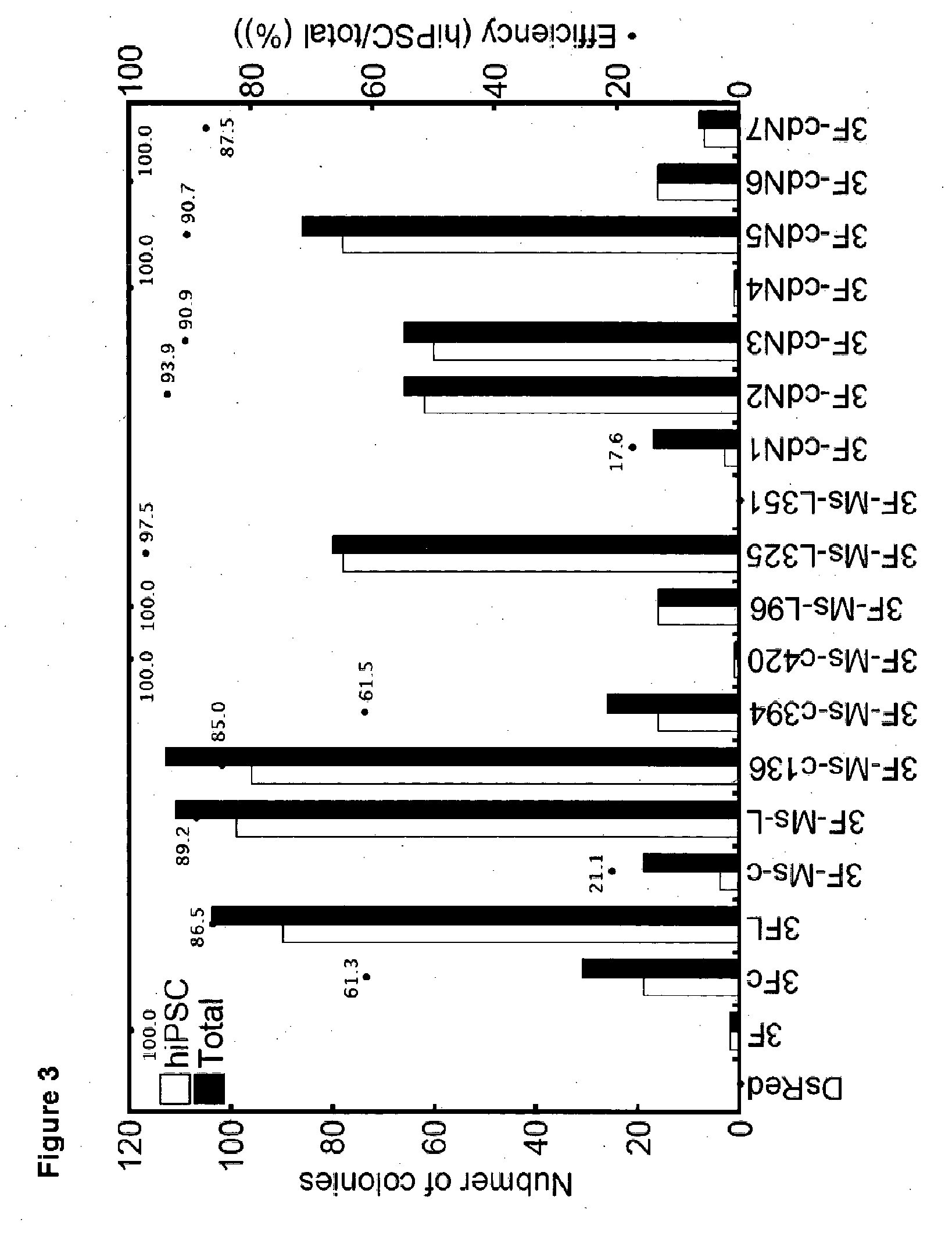Method for improving induced pluripotent stem cell generation efficiency
- Summary
- Abstract
- Description
- Claims
- Application Information
AI Technical Summary
Benefits of technology
Problems solved by technology
Method used
Image
Examples
example 1
Study on Induction of iPS Cells with a Variant of c-MYC having N-terminal Deletion
[0286]1) Preparation of Retroviral Vectors Encoding Variants of Human c-MYC having N-terminal Deletion
[0287]Retroviral vectors encoding variants cdN1 to cdN7 of human c-MYC having N-terminal deletion were prepared. Firstly, fragments were amplified by PCR using human c-MYC cDNA as a template and the following sets of primers.
[0288]
(SEQ ID NO: 11)dN1-sCACCATGCTCGACTACGACTCGGTGCAGCC(SEQ ID NO: 12)dN2-sCACCATGCCCCCGGCGCCCAGCGAGGATAT(SEQ ID NO: 13)dN3-sCACCATGCGCCGCTCCGGGCTCTGCTCGCC(SEQ ID NO: 14)dN4-sCACCATGCGGGGAGACAACGACGGCGGTGG(SEQ ID NO: 15)dN5-sCACCATGGGAGACATGGTGAACCAGAGTTT(SEQ ID NO: 16)dN6-sCACCATGATCATCATCCAGGACTGTATGTG(SEQ ID NO: 17)dN7-sCACCATGGCCGCCAAGCTCGTCTCAGAGAA
[0289]
(SEQ ID NO: 18)HsMyc-ASTCACGCACAAGAGTTCCGTAGCTGTTCAAG
[0290]The LR reaction between pENTR-D-TOPO-cdN1 to cdN7, which were obtained by cloning each of the resulting fragments into pENTR-D-TOPO (Invitrogen), and retroviral vector...
example 2
Investigation of Induction of iPS Cells with a Variant of Human c-W135E having N-terminal Deletion
[0299]1) Preparation of Retroviral Vectors Encoding Variants of Human c-W135E having N-terminal Deletion
[0300]Point mutation of human W135E was introduced by carrying out PCR using pENTR-D-TOPO-cdN1 to cdN6 constructed in Example 1-1) as a template and using primers [OLIGO1: CAGGACTGTATGGAGAGCGGTTTCT (SEQ ID NO:19); and OLIGO2: AGAAACCGCTCTCCATACAGTCCTG (SEQ ID NO:20)]. After the point mutation was verified by sequencing, the LR reaction with retroviral vector pMXs-gw was carried out to prepare pMXs-c135dN1 to c135dN6.
[0301]2) Verification of Expression with Western Blotting
[0302]The retroviral vectors pMXs-c135dN1 to c135dN6 were individually introduced into Plat-E cells, in the same manner as in Example 1-2). Then, western blotting was carried out by a conventional method using a lysate of the Plat-E cells. The results are shown in FIG. 4. From the fact that a band of endogenous c-MYC...
example 3
Investigation of Induction of iPS Cells with Variants of L-MYC Derivatives having N-terminal Deletion
[0305]1) Preparation of Retroviral Vectors Encoding Variants of Human L-MYC having N-terminal Deletion
[0306]Retroviral vectors encoding variants LdN2, LdN4, LdN5, LdN6 and LdN7 of human L-MYC having N-terminal deletion were prepared (excepting L-MYC variants corresponding to cdN1 and cdN3; see FIG. 1). Firstly, fragments were amplified by PCR using human L-MYC cDNA as a template and using the following sets of primers.
[0307]
(SEQ ID NO: 21)LMyc-dN2-sCACCATGTCCACGGCGCCCAGCGAGGACAT(SEQ ID NO: 22)LMyc-dN4-sCACCATGTGGGGCTTGGGTCCCGGCGCAGG(SEQ ID NO: 23)LMyc-dN5-sCACCATGGGAGACGAAGCGGAATCCCGGGG(SEQ ID NO: 24)LMyc-dN6-sCACCATGATCATACGCCGTGACTGCATGTG(SEQ ID NO: 25)LMyc-dN7-sCACCATGCGGGAACGGCTGGAGAGAGCTGT
[0308]
(SEQ ID NO: 26)Hu-L-Myc-as2TTAGTAGCCAGTGAGGTATGCAATTC
[0309]The LR reaction was carried out between pENTR-D-TOPO-LdN2, -LdN4, -LdN5, -LdN6 and -LdN7, which were obtained by cloning each of...
PUM
| Property | Measurement | Unit |
|---|---|---|
| Efficiency | aaaaa | aaaaa |
Abstract
Description
Claims
Application Information
 Login to View More
Login to View More - R&D
- Intellectual Property
- Life Sciences
- Materials
- Tech Scout
- Unparalleled Data Quality
- Higher Quality Content
- 60% Fewer Hallucinations
Browse by: Latest US Patents, China's latest patents, Technical Efficacy Thesaurus, Application Domain, Technology Topic, Popular Technical Reports.
© 2025 PatSnap. All rights reserved.Legal|Privacy policy|Modern Slavery Act Transparency Statement|Sitemap|About US| Contact US: help@patsnap.com



